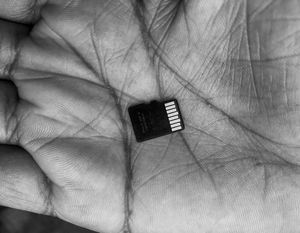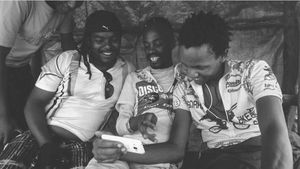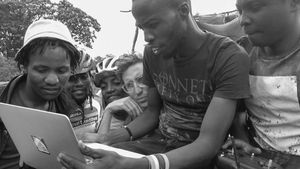NRB DSTRBTD
2024
Nairobi Distributed - Introduction (excerpt)
Excerpt from forthcoming book
A Prelude
Sometime in early 2013 I was walking home along State House Road. It was late afternoon and the traffic was heavy. I walked uphill past the YMCA, past the University of Nairobi and as I neared the corner of Arboretum Drive I passed a small lane on my right, where a number of Bodaboda drivers waited with their motorbikes. I nodded a greeting and carried on walking, but out of the corner of my eye I noticed that one of the drivers was wearing a new vest. It was red, and on the back was written "DNA ni TNA". It took me a few steps to decipher the letters; it was a new political slogan. TNA stood for The National Alliance, a newly-branded political party in Kenya which brought together the former rivals William Ruto and Uhuru Kenyatta. And DNA is, well DNA, the building blocks of our genetic code.
At first glance "TNA is DNA" is an easy political slogan which simply suggests the strength of The National Alliance. But as I walked on I sensed a much more sinister dimension to this wordplay. By equating a political identity with a genetic one "TNA is DNA" also whispered the suggestion that ethnic groups are biologically different from one another. The fact that Kenyan politicians were instrumentalising ethnicity in the 2013 elections was almost unbelievable. The previous elections in 2007 had sparked the worst political violence since independence; well over a thousand lives were taken, hundreds of thousands of people had lost their homes, and international mediation had been required to negotiate a peace settlement. At the heart of this catastrophe was the politicisation and weaponisation of Kenyan ethnic identity. Not only that you should vote for someone from your ethnicity but the idea that your ethnic identity that makes you fundamentally different; it is your DNA.
In February 2009 Turbulence came to Kenya. It was the first time that the Jamaican Rastafarian and reggae star was performing in Africa and there was a huge anticipation and build up to the concert. Metro FM, the reggae radio station which was hosting the event had been promoting it heavily for at least a month. From street vendors to local cultural institutions, it felt like all that everyone was talking about was the Turbulence gig. When he arrived he was taken straight from the airport to the Metro FM radio station to do an exclusive interview for the breakfast show. In the evening, I went with a group of friends to see him perform before a crowd of thousands at Splash Waterworld. The hyping and build up continued; the Kenyan reggae artists who were the warm up acts, whipped the crowd into a frenzy by dedicating different songs to particular matatu routes.**1**
Witnessing the excitement and euphoric celebrations around me when individuals and groups heard their route number called out was a kind of revelatory experience. This seemed to be a completely different kind of identity to the fixed and politicised ideas of ethnic identity seen in the post-election violence of 2007/8. The dedications were not in an ethnicity-specific language to particular ethnic groups, they were called out in Sheng, the Kenyan slang, and were for an entire route, something without a single point of origin which traverses the city. These shout-outs manifested a kind Nairobi belonging, youth-centred, performed and constantly changing.
I start with these brief snapshots of Nairobi life because they seem to encapsulate the fundamental questions about ethnic identity and belonging which are at the heart of this book. On the one hand, there is a political sphere which is typified by a highly-politicised idea that an ethnic identity is a fixed characteristic that you are born with, and which defines you for the rest of your life. And on the other hand there is the clamour and complexity of urban existence which consists of many ways of being and multiple forms of belonging. How does the former relate to the latter? It is complicated, because the political realm is not separate from the everyday, but enmeshed within it and ethnic identities are not just simple political tools, they are complex, lived realities. Indeed the more you look into Kenyan ethnicity, the more complicated it appears, because it is simultaneously totally different things; invented and inherited, political and cultural, experienced and imagined.
The Premise
This book is an attempt to try and disentangle political narratives of ethnic identity from the way in which identities are actually experienced, performed and practised in day to day life. I approach the question indirectly, through a number of collaborative art projects in Eastlands, Nairobi. These projects explore digital video as a form of collective story-telling, hence they offer an invaluable perspective on how young people chose to represent themselves and their environment. Furthermore these collaborative endeavours, which were complicated and often flawed, were nonetheless sustained collective processes which took place over months and sometimes years. I reflect on the films we made, the way in which we made them, and the broader experience of these projects to make a number of proposals about the contextual and situational nature of belonging in Nairobi's Eastlands.
Drawing on the experience of art projects to make an argument about ethnic identity has been both rewarding and challenging. On the one hand these projects and films are a very special example of how young people represent and understand their identities. Writing about how particular groups and individuals live and practice their identities, offers a vital specificity to a long and ongoing debate about ethnicity in Kenya. But on the other hand, I have struggled to bring this material, the films we produced and experiences we had, into conversation with scholarly debates on this topic. Do these films and experiences illustrate existing academic scholarship, or are they their own kind of evidence? What exactly is their status? How to write about this in a manner which opens up them up for inquiry, rather than closing them off as fact. Furthermore how to do justice to the complexity of the scholarship which I refer to, but write in a language which non-academics can understand?
Indeed there are a number of central paradoxes to what I am trying to do in this book. This is a non-academic study which is a nonetheless a work of careful artistic research, it is an account of collaborative processes that is written by one person, and it is an inquiry into Kenyan ethnicity by someone who is not ethnically Kenyan. I have tried to address these fundamental questions by writing, structuring and organising this book in a deliberate and unconventional way, which I outline in the preamble. What I would like to emphasise here is that my approach to writing, indeed this whole book is an experiment and an attempt but it is not a solution. Perhaps at times I might get carried away, but please read the pages that follow as a set of respectful proposals rather than an opinionated polemic.
The Proposal
As I take a slightly unusual approach in this book, bringing together discussions of Kenyan identity with a collaborative practice rooted in Contemporary Art, I think it is important to use the introduction to give some historical context to these fields. Because, whilst this book is about the ways in which young people experience and experiment with different identities, these endeavours acquire another level of meaning and significance, when seen in the broader context of Kenyan social and political life. Rather than a summary of the chapters to come, this introduction is more like a setting of the scene, or an operating manual. I hope that it will equip readers with a set of tools with which to interpret the book. It consists of four parts.
I start by outlining the contours of discussion about ethnic identity in Kenya that this book and these projects are based upon. I propose that ethnicity is a racist construct that was nurtured by the British colonial administration. But I also argue that it is vital and fundamentally Kenyan. How can ethnicity be both a colonial construction and a deeply rooted series of beliefs and knowledge? I try and reconcile these seemingly conflicting ideas by distinguishing between politicised ethnic identity (of categories and cliches), and a cultural ethnic identity (of experiences and practices). These are totally different types of ethnic identity, yet they are intertwined and co-exist. Nevertheless, although there are innumerbable accounts, both popular and scholarly, of the complexity of lived identities, it is the simplified narratives which seem to dominate the political and the public sphere. Why is this the case? The key word here is seem.
Ultimately I cannot know, in a lived and experienced way, about Kenyan ethnicity because I am not ethnically Kenyan. In the central part of the introduction I address the fundamental question about both how and why I have worked on these projects and written this book. I discuss my limitations in understanding Kenyan ethnicity and identity as someone who stands outside of these processes. And I try and articulate my position as someone who is not Kenyan, yet deeply entangled in the history of the country. However, as both an outsider and white man, there is a big question not so much regarding if I can, but if I should participate in such delicate discussions. I do not, and cannot conclusively answer this question and I have many doubts about the legitimacy of this whole project. However, at this moment in time, these concerns are outweighed by what I perceive as the political necessity of sharing identity narratives which counter the current dominant and toxic narrative of Kenyan ethnicity.
I currently believe that the question is not if, or should, but how I can participate in ongoing debates on Kenyan identity. In the final section to this introduction I make the case for collaboratively-produced art projects as a way of co-authoring rich and complex stories of belonging. These projects are by no means a perfect, or best-case practice. Indeed, in the main sections of the book I will discuss the blind spots and clumsy nature of our endeavours. Nevertheless, collectively defining what films to make, and building organisations and working structures together has a powerful ethical and equitable potential. In fact, the fluid, process-based nature of these projects enables them to absorb the identity projects of the people involved, and become enmeshed within their specific social and political contexts. I try and sum up what collaborative art projects are, or rather how i understand them, by distinguishing between three modes of working together; participation, collaboration and co-production. This is both a subjective and personal overview, in part because I think readers can better interpret the projects in the main body of the book if they have a sense of my personal context.
The entanglement of these projects within my personal and subjective experience is the point of departure of the final part of this introduction. I consider this art practice as a form of research, arguing, perhaps counter intuitively, that it is valuable precisely because it is not objective, dispassionate or impartial. I sketch out how I understand, and relate to the growing field of artistic research, a way of knowing that acknowledges and values the uniqueness and specificity of art practice. Personally, I see the crux of artistic research however, in its ability to articulate itself and be understood as research which in this case this has resulted in an attentiveness to the way of writing and the form of the book. I conclude the introduction with some thoughts on the parallels between artistic research and decolonial thinking, in their aims to decentre and pluralise the production of knowledge.
https///www.iwalewabooks.com/product-page/nrb-dstrbtd


